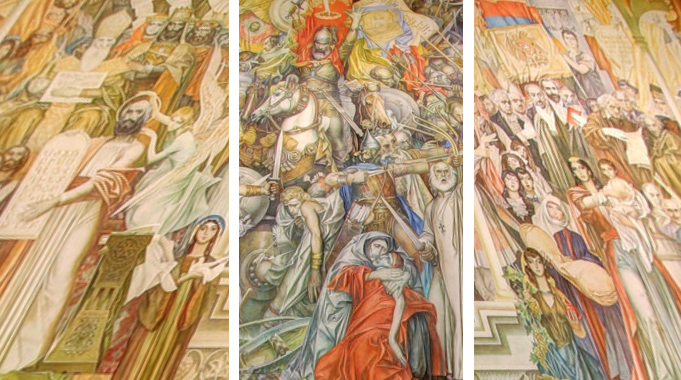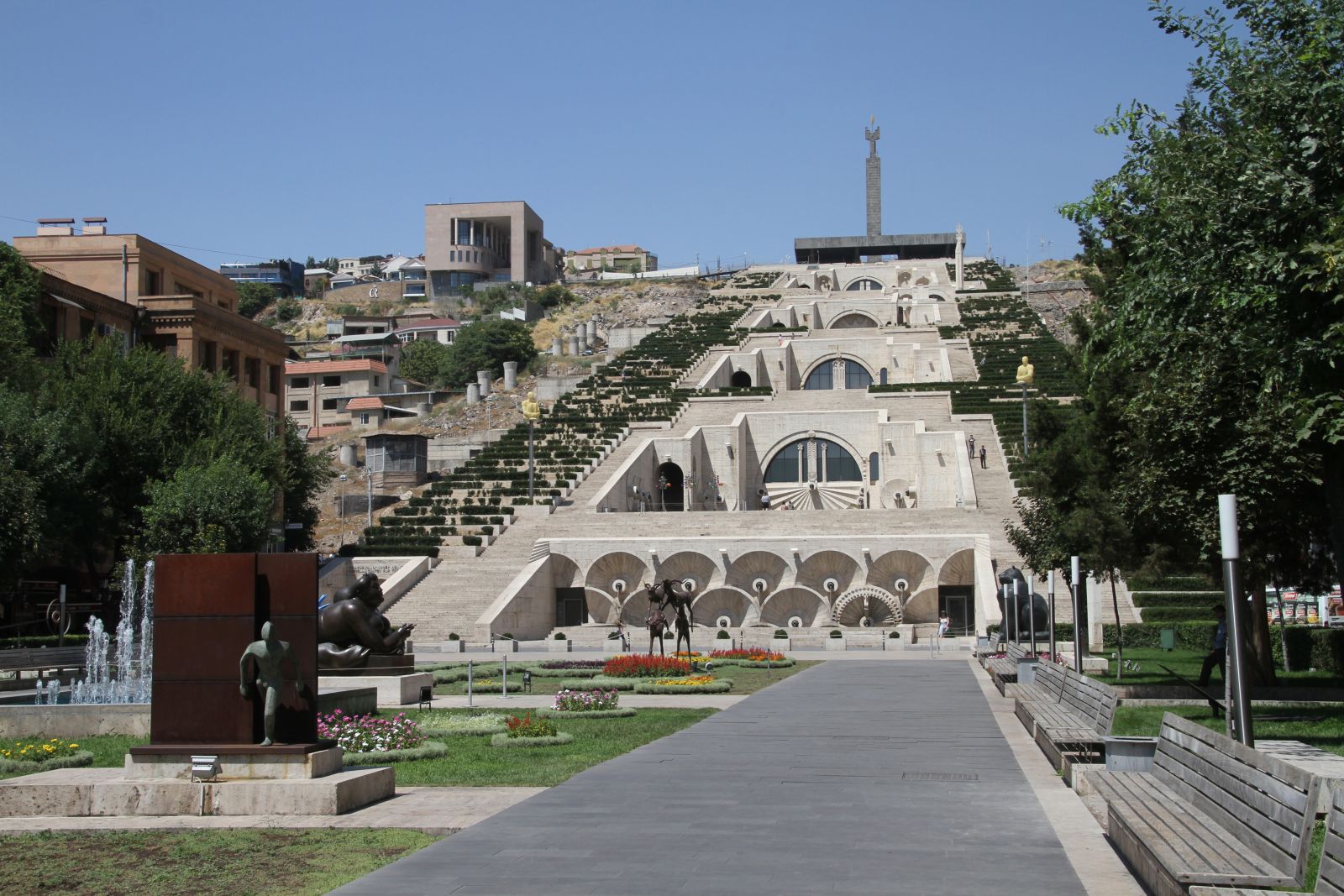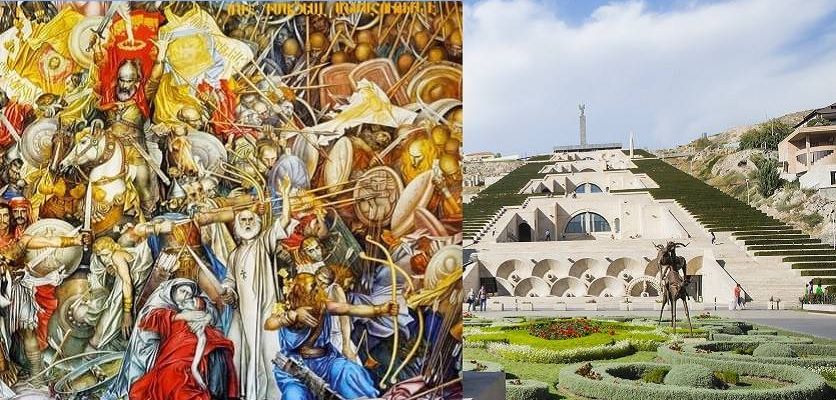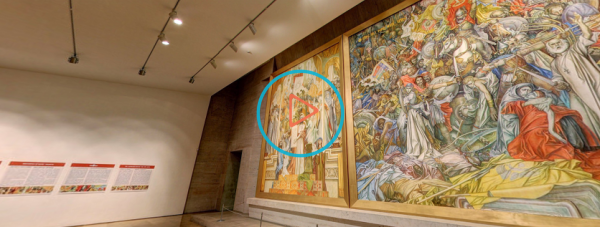At the Cascade Complex: The masterwork that Khanjian painted till his last breath
November 29, 2021
Grigor Khanjian spent the last chapter of his life in a vast open-air space, painting a mural that would soon be hailed as an iconic rendition of Armenian history. What urged him to undertake such a huge project?
Located at one of the spacious exhibition halls of the Cafesjian Center for the Arts inside Yerevan’s giant marble staircase, the Cascade Complex, Grigor Khanjian’s massive mural enchants both Armenian and foreign visitors.
The monumental piece is a triptych inspired by the works of Mexican artists like Diego Rivera and David Alfaro Siqueiros, as well as by incredible masterpieces such as Michelangelo’s frescoes in the Sistine Chapel.
It consists of three separate panels which depict crucial episodes in Armenian history: “The Creation of the Armenian Alphabet,” “The Battle of Avarayr (Vardanank),” and “The Rebirth of Armenia,” all painted between 1992 and 2000.
 “The Creation of the Armenian Alphabet,” “The Battle of Avarayr (Vardanank),” and “The Rebirth of Armenia” (screenshots: 360 Stories)
“The Creation of the Armenian Alphabet,” “The Battle of Avarayr (Vardanank),” and “The Rebirth of Armenia” (screenshots: 360 Stories)Illuminating a tapestry design in mural form
Before undertaking the arduous task of painting the triptych, Khanjian had designed a two-part tapestry that was woven in France and hung within the Etchmiadzin Cathedral Museum. It was greatly admired and praised, but remained inaccessible to the public. To surmount this limitation, the painter recreated his tapestry design in mural form. He added a third panel, and worked alfresco on the enormous project while his own life was fading away.
As The Armenian Reporter once poignantly described, “His last days on the scaffold were in bitterly cold weather; old, sick, and eyesight failing, he seemed to know the end would come soon. On the day before his death, working on the final panel, ‘The Rebirth of Armenia,’ he summoned his last reserves of strength, completing—one could say illuminating—in a single day the critical central area that had remained unfinished.”
The incredible efforts that had gone into applying those last brush strokes were not in vain. Hours before the artist took his final breath, he managed to paint the iconic image of Mother Armenia and her child (the latter representing the future of our country), leaving his creation to be completed by Henrik Mamyan.
 Khanjian's triptych is located at one of the spacious exhibition halls of the Cafesjian Center for the Arts inside Yerevan’s giant marble staircase, the Cascade Complex (Photo: Wikimedia Commons)
Khanjian's triptych is located at one of the spacious exhibition halls of the Cafesjian Center for the Arts inside Yerevan’s giant marble staircase, the Cascade Complex (Photo: Wikimedia Commons)A tribute to turbulent times
Khanjian lived in turbulent times. This may explain why he incorporated so many historical themes into his triptych. The artist had witnessed the rise and fall of the Soviet dictator Stalin, the horrors of WWII, Armenia’s struggle for independence in the early 1990s, of which he was an active supporter, and the strengthening of the Armenian Apostolic Church—an important development for Khanjian who was a staunch Christian in belief.
The result was a masterfully executed composition, filled with symbolism that could take years to untangle. There is an intriguing aspect to the triptych: prominent figures from different periods of Armenian history—like Hovhannes Tumanian, Paruyr Sevak, Avetik Isahakian, Alexander Tamanian, Komitas Vardapet, Aram Khachaturian, Movses Khorenatsi and Elishe, including Khanjian himself, are portrayed amidst critical historical events, as if they exist out of time. This artistic choice reflects Khanjian’s desire to demonstrate the profound impact of writers, poets, architects, sculptors, and painters on pivotal moments in Armenian history.
We meet Armen Yesayants, director of exhibitions at the Cafesjian Center, who explains: “Historical and cultural figures are incorporated into the centerpiece of the mural, the illustration of the ‘Battle of Avarayr,’ in recognition of their role in preserving the Armenian identity. Some of these figures are celebrated for their commitment to their values. They symbolize our collective spirit and unity. The Battle of Avarayr was fought to prevent assimilation and to secure our national identity.”
The left panel shows yet another important event: the creation of the Armenian alphabet in 405 AD which was crucial in anchoring Armenian identity. At the center of the panel, we see Mesrop Mashtots, the learned monk who took upon himself the mission of inventing the Armenian letters. Surrounded by religious figures, he proudly upholds the Armenian script—the basis of the development of Armenian language.
Finally, the right panel, which Khanjian was sadly unable to complete himself, portrays the symbolic rebirth of Armenia through the depiction of the Armenian coat of arms and the Armenian flag. The figure of Mother Armenia holding her child instantly stands out in the center of the painting. The panel makes references to major events of the twentieth century: the short-lived independent Armenian state that emerged—for the first time after centuries of foreign rule—against the backdrop of the Armenian Genocide in 1915; the Soviet annexation of Armenia that followed soon after; the devastating earthquake of 1988; the fight for the liberation of Artsakh; and the resurrection of Armenia as an independent nation after the fall of the Iron Curtain.
“In the ‘Battle of Avarayr’ Mother Armenia is portrayed sitting on the ruins of the country, while in the third panel she rises as a symbol of cultural rebirth and independence in the twentieth century,” observes Yesayants.
National modernism: beyond image
Khanjian was one of those rare artists who collaborated both with the state and the church during the Soviet years. An outstanding graphic artist, an excellent book illustrator and a gifted interior designer, he came up with a brilliant idea of rejuvenating national and folk culture through modernism.
Renowned for his illustrations of Hovhannes Tumanian’s “Loretsi Sagon” («Լոռեցի Սագոն» | “Sako from Lori”), Paruyr Sevak’s “Anlreli zangagatun” («Անլռելի զանգակատուն» | “The Unsilenceable Belfry”), and Khachatur Abovian’s “Verk Hayastani” («Վէրք Հայաստանի» | “The Wounds of Armenia”), he made his way into every Armenian household.
“Being an avid researcher, Khanjian meticulously explored the past. He did a thorough study before painting his pieces to be as historically accurate as possible—from weapons to costumes and armor. He used the same approach in his remarkable book illustrations, striving to make the text visible through images. This is a vital point and is frequently overlooked by readers who fail to appreciate the subtle illustrations; sometimes they do not even bother to find out the name of the illustrator,” points out Yesayants with regret.
Many of Khanjian’s designs for church interiors, doors, chairs, wall decorations, and candleholders were implemented. The doors of the Geghard Monastery and the reception hall of the St. Hripsime Church, as well as the doors of the Sharambeyan Folk Art Museum in Yerevan and the wall designs of the Alex and Marie Manoogian Museum in Detroit are the product of the artist’s hard work and unique imagination.
Khanjian received a number of prestigious awards and held high-ranking positions. He was a well-known artist in the Soviet Union. His paintings appeared in many publications, and he took part in various exhibitions. Yet he never had a solo exhibition in Armenia.
Five years ago, the Cafesjian Center for the Arts marked the ninetieth birthday of the artist by fulfilling one of his life-long dreams and opening an exhibition entitled “Grigor Khanjian: Beyond Image,” paying tribute to the painter celebrated for his gigantic triptych, presenting him as an equally skilled graphic artist. The exhibition included never before seen graphic sketches acquired from private sources and Khanjian’s family collection—fragments that had been sent to France to be woven into “The Armenian Alphabet” tapestry, dense and detailed sketches for Abovian’s novel, “The Wounds of Armenia,” as well as works that the artist intended to display in a solo exhibition.
Next time you wander around the cascade, be sure to take a moment to step into the museum and view the multilayered triptych through different angles. Bear in mind that the doors you walk through and the benches you sit on are all designed by Khanjian himself!
Join our community and receive regular updates!
Join now!





Attention!